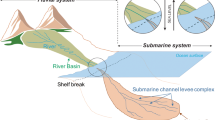Abstract
Jones Creek, South Carolina, connects two hydrographically distinct estuarine systems: North Inlet and Winyah Bay. One hundred fifty-two sets of hydrographic measurements from February 1978 indicate the existence of a Jones Creek nodal point, an effective barrier limiting flow exchange between the end regions of the creek. Morphologic and vegetation observations and water quality ratings suggest that this nodal point is a permanent feature of Jones Creek and may be present in other similar systems.
Similar content being viewed by others
Literature Cited
Bowman, M. J. 1976. The tides of the East River, New York. J. Geophys. Res. 81(9):1609–1616.
Cox, R. A., F. Culkin, and J. P. Riley. 1967. The electrical conductivity/chlorinity relationship in natural sea water. Deep-Sea Res. 14:203–220.
Foerster, J. W. 1968. A portable non-electrical current meter. Chesapeake Sci. 9:52–55.
Kjerfve, B. 1975. Velocity averaging in estuaries characterized by a large tidal range to depth ratio. Estuarine Coastal Mar. Sci. 3:311–323.
— 1976. Circulation and salinity distribution in coastal Louisiana bayous. Contrib. Mar. Sci. 20:1–10.
— 1978. Bathymetry as an indicator of net circulation in well mixed estuaries. Limnol. Oceanogr. 23(4):816–821.
—, And J. E. Greer. 1978. Hydrography of the Santee River during moderate discharge conditions. Estuaries 1(2):111–119.
LeBlond, P. H. 1978. On tidal propagation in shallow rivers. J. Geophys. Res. 83(C9):4717–4721.
Perkin, R. G., and E. R. Walker. 1972. Salinity calculations from in situ measurements. J. Geophys. Res. 77:6618–6621.
Pritchard, D. W. 1955. Estuarine circulation patterns. Proc. Am. Soc. Civil Eng. 81:717/1–717/11.
— 1960. Salt balance and exchange rate for Chincoteague Bay. Chesapeake Sci. 1(1):48–57.
—, And W. V. Burt. 1951. An inexpensive and rapid technique for obtaining current profiles in estuarine waters. J. Mar. Res. 10:180–189.
—, And G. B. Gardner. 1974. Hydrography of the Chesapeake and Delaware Canal. Tech. Rept. 85. Chesapeake Bay Institute, The Johns Hopkins University, Baltimore, Md.
Sioli, H. 1966. General features of the delta of the Amazon, p. 381–390. In Scientific Problems of the Humid Tropical Zone Deltas and their Implications. UNESCO.
South Carolina Department of Health and Environmental Control. 1978. Water classification standards system for the State of South Carolina.
South Carolina Pollution Control Authority. 1972. Stream classifications for the State of South Carolina, Columbia, S.C. 24 p.
United States Geological Survey. 1979. Water resources data for South Carolina, water year 1978. Columbia, S.C. 248 p.
van de Kreeke, J. 1978. Mass transport in a coastal channel, Marco River, Florida. Estuarine Coastal Mar. Sci. 7:203–214.
Author information
Authors and Affiliations
Additional information
Contribution No. 309 of the Belle W. Baruch Institute for Marine Biology and Coastal Research, University of South Carolina, Columbia, South Carolina 29208.
Rights and permissions
About this article
Cite this article
Schwing, F.B., Kjerfve, B. Longitudinal characterization of a tidal marsh creek separating two hydrographically distinct estuaries. Estuaries 3, 236–241 (1980). https://doi.org/10.2307/1352078
Issue Date:
DOI: https://doi.org/10.2307/1352078




